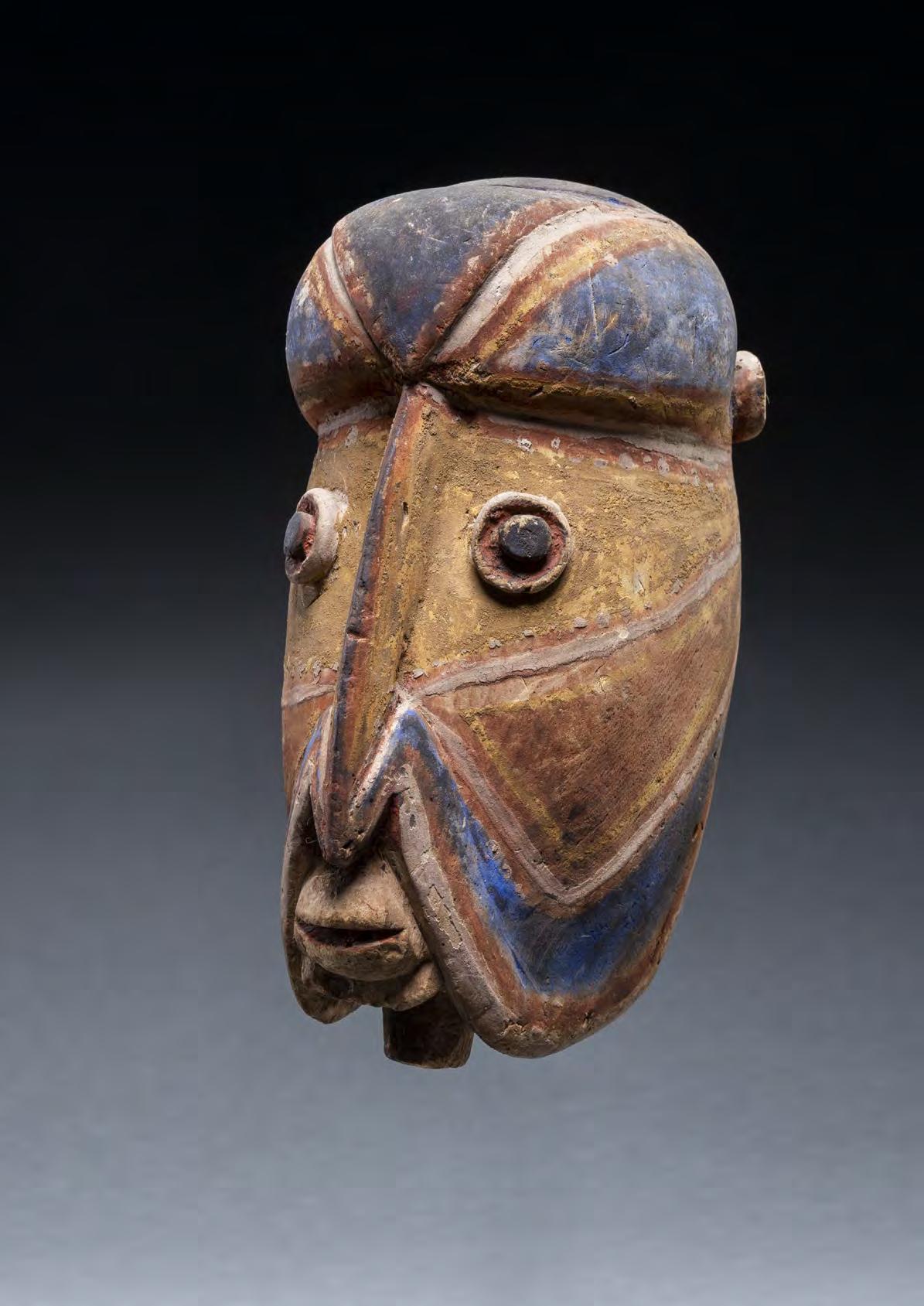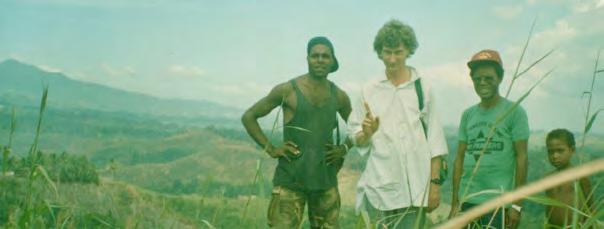
21 minute read
My Field Collecting Career
By Michael Kremerskothen
I was attracted to art in a broader sense from a very early age and grew up with old art and antiques. As a teenager, museum visits were an important and enjoyable part of my experience. In childhood I learned to love the North American Indians through old books, because of their very nature-oriented way of life and their beautiful cultural objects.
Advertisement
During my studies, I also became involved with their wise view of the world. As a high school student, I saw books about the primitive peoples of Papua New Guinea and felt these cultures to be as very strange, mysterious and original. It was only many years later that I suddenly and unexpectedly had the opportunity to travel to these regions.
This stimulated me to deal with the art of the different regions, through literature, museum visits and the exchange with other collector friends. A special pleasure for me were the hours of intensive discussions about the expressiveness and quality of the objects and quality of the objects in various museums in Germany, Europe and overseas, which I especially enjoyed visiting with long-time collector friend Klaus Maaz.
Also the important auctions, exhibitions and fairs in the 90 gladly in London, later in Paris, Amsterdam and Brussels and also occasionally in the USA were and still are an enrichment. I was also very impressed by the inspiring effect of the Oceanic cultural objects on the artists after 1900, for their art had long appealed to me. This tribal art with all its facets will delight and inspire me throughout my life to understand it even more deeply and inspire me to understand and feel it even more deeply.
TRAVELS Between 1988 and 2001 I made at least one two-month trip per year—totally 16 trips at 2 months each and one of a four-month stay. In the East Sepik Province, starting from Wewak, I visited the islands of Kairiru, Mushu, Tarawai, Walis and the Schouten Islands. I collected in some villages along the northern coast road like Wonginara.
My specialty was the Boiken area--all villages from Wewak to Passam. Then from the junction in Passam the whole region to Angoram on the Sepik. Along the road towards Maprik, from Passam to the junction in Hayfield all villages right and left—both Boiken and Abelam including the Sepik plains and the Roma. I collected in the entire Abelam area from the north to the south to Pagwi including Yama.
Furthermore, I made trips to the West, Eastern and Southern Highlands including the Lake Kutubu region. From Port Moresby I explored the Woitape-Tapini region. In Milne Bay Province, I first traveled along the mainland and then visited almost all the islands. In Madang Province I collected on Manam Island and in the whole region around Bogia far into the grassland.
From what is known as Base Camp I canoed along the Ramu River to the south and then along the Guam River. There I explored all the tribes of the region including the region around Josephstaal and from there back to Bogia.
In West New Guinea, I visited Lake Sentani from Jayapura, then various villages in the region from Wamena. Finally, I explored the Asmat area around Agats and Merauke before flying back to Bali. In Australia, I contacted dealers and also collectors in Cairns, Brisbane and Sydney.
Over all these years several thousand pieces from different regions passed through my hands. This enriched my wealth of experience and as a result I learned much more about age, patina, the style variations, the design power and the cultural background of the objects.
In order to be able to finance my travels, I built up contacts with many important dealers and auction houses in Europe and the USA.
COOPERATION WITH THE NATIONAL MUSEUM Before I started my respective journeys to the most different tribes of Papua New Guinea, I contacted the National Museum in Port Moresby. This cooperation led to regular inspections of the pieces I had acquired, before I was issued the necessary export certificate. In addition, cultural items very important to the museum I was happy to donate on a regular basis.
IN THE FIELD The collecting expeditions took me to the most remote regions possible, which I discovered by studying maps. To please the people, I brought metal boxes full of coveted foodstuffs and various utensils as gifts to the villages. This was for me like a time travel into a still quite original world, in which humans and the plants and animal world surrounding it were self-supporting and interconnected.
I felt privileged to have the unique chance to be taken into these still quite untouched human communities for a certain time, to share with them the daily life and to exchange ideas about the things of life. To bathe in the early morning in the crystal clear water of a river, surrounded by a green paradise and the sound of exotic bird songs. The evenings were often spent after a common meal under the immense starry sky around an open fire, sharing stories from their world and mine in the local language, Tok Pisin.
Over time, I was allowed deeper insights into cultural contexts. I was also allowed to participate in some ceremonies still taking place among the Abelam people. In many regions I was welcomed again and again as a guest during all these years.
The contact and exchange with many of the old wise men (Big Man + Chiefs) of the most different regions made me sadly realize how much of their old traditional magical understanding of the world, which allowed these cultures to survive successfully over centuries, were now visibly left alone and no longer respected by the majority of the younger generation. The missionaries and the advancing

modern life have disempowered the old culture to a large extent and pushed it to the margins of life. The very old traditional world with a still quite intact tribal culture was only continued to be upheld in rather remote areas. This was evident in carvings for certain festive occasions and rituals from older and more recent times, which could also be of high artistic quality. On the one hand, with the purely individual artistic talent, experience and maturity of the creator plays an important role. If his basic idea penetrates the whole work into all important elements, in order to still increase this in its effect with an individual touch, with an unexpected and surprising variation of design, then one can speak of perfection of form, a particularly successful work. Regardless of the individual aesthetic ability of a sensitive carver, his spiritual immersion in the magical cosmos of culture, the sensation and emotion in his deep faith is of elementary importance for the expressiveness and radiance and thus the quality of a cult object always and fundamentally follows a culturally conditioned canon of design.
Thus, a masterpiece is permeated by the union of the highest aesthetic demands with the inspiring, essential and magical energy of origin.
In this context I refer to works of art, which were produced in a time, when the existence of the white man was still unknown. Such cultural objects, inherited over generations, with an extremely reduced formal language, were kept in secret places and were often characterized by a much deeper, magical and soulful expressiveness, which was further emphasized by the rich patina and the very soft-looking lines.
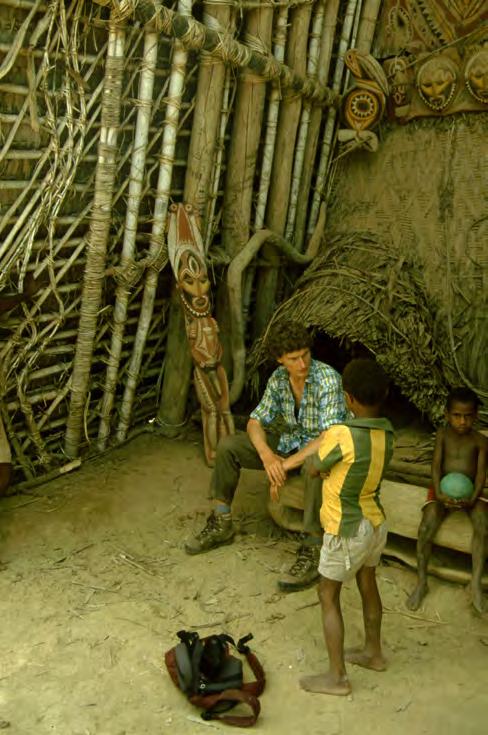
COLLECTING ACTIVITIES In most cases, important inherited objects were left to me by younger people, because they could improve their economic situation, for example, by planting vanilla plantations. The fathers or grandfathers found it much more difficult to part with inherited cult objects, because they feared to lose the source of strength of their existence, even if their children did not want to believe this anymore.
Although on the one hand it was not easy for me to give up pursuing a wonderful old mask of an older man, I was touched by his deep belief in its elementary power for securing the living conditions of his community. This he manifested with a strong sense of responsibility even as his sons completely disagreed.
Sometimes fragments of figures I acquired were kept back, in order to be able to transfer from them the magic and power into other carvings. Once, after acquiring a figure, I noticed how an elderly man, painted in the face, seized it by the head while his whole body was trembling, and his skin was wet with beads of sweat. Later it was whispered to me that he had drawn the secret powers from the carving so that he could later channel them into another object.
Sometimes I was able to save works directly from decay through my purchase, because those responsible had in these cases had thrown the inherited carvings into the jungle for reasons unknown to me.
NOW SOME THOUGHTS AND QUESTIONS ABOUT THE ART OBJECTS These are my personal views based on my experiences, adventures and impressions at the cultures I visited in Papua New Guinea about what they embodied and what they stood for in the still living cultural environment.
The ancestral portrait was a representative of the self-image of the tribe, an embodiment and a guardian of the spiritual-cultural cosmos, in which the group members, guided by appropriate rituals, grew from the young initiate up to the wise Big Man matured in the responsibility for the whole. Through the recurring ritual visualization of the principles and wisdom of the culture, it was renewed and vitalized.
These ancestor-od figures were and are effective in their multi-layered presence: Eternal, essential, elemental, sublime, serious, austere, self-contained, sovereign, resolute, grounding, sacred, supernatural, inspirational, powerful, energetic, powerful, perilous, demanding, relentless, concentrated, focused, magical, and soulful. Their magical energy potential was further enriched and heightened by motifs and elements often borrowed from the animal world.
One turned to the sacred sculptures with the highest respect, devotion, reverence, gratitude and awe because one owed them the gift of the presence on all levels. Basically, one hoped for help and support from them for the life to be mastered, the struggle for life with all its facets, surrounded by an immense natural world.
This requested help was the magical internalized life force, a source of origin, a source of power, an elixir of life, a divine spark, an inspiration, which permeates everything and brings it to perfection, for the benefit of the community. It is an elemental energy that makes everything succeed and supports everything, a magic, a magic remedy.
ATTEMPT TO INTERPRET THIS ART FOR US TODAY FROM A PERSONAL POINT OF VIEW These soulful cultural objects, charged with magical powers, with their unbelievable variety of representational forms and an often high artistic sensibility seem to have a longing and fascination for us modern people. As sensitive cultural people, who still carry at least a spark of the magical thinking of early childhood, they let us sense some of the soulful power which the artist has invested out of deep feeling.
In our childhood we were closer to the animistic and magical thinking of primitive peoples. Due to the excessive emphasis on rational and purposeful thinking of modernity, our emotional levels suffer. These works of art enrich us emotionally and spiritually by harmonizing our inner being and bringing it into balance.
We should try to strengthen the emotional, connect more inwardly with people, animals and the plant world, to be able to be more ourselves and more human. The works of art of the tribal peoples with their original energy are helpful for us, to feel more in harmony with our world. Through their soulful power and magic, they open our senses to the unconscious, to the enigmatic, the veiled and mysterious. They touch us, challenge us to broaden our perspective and to focus on the essential.

25 Guam River Hornbill Dance Carving
Isarikan village, Guam River area, Madang Province, Papua
New Guinea Field collected by Michael Kremerskothen, Dortmund,
Germany Pre-contact, stone-carved, 19th century 30 ½” (77.4 cm) in height
The Guam River is a very remote tributary to the east of the middle Ramu River. The anthropologist Dirk Smidt has written about the one-legged figures from the Kominimung people, but, other than this, there is virtually nothing on this amazing art-producing area. As this hornbill carving attests, the precontact style is raw and powerful.


26 Telefomin Shield, Atkom
Telefol culture, Kubrenmin parish, Oksivip village, Ifitaman Telefolmin, Sandaun (West Sepik) Province,
Papua New Guinea Collected by Patrick Batina Michael Hamson, Palos Verdes Estates, California Paul Harris, Anchorage, Alaska Jolika Collection of John and Marcia Friede, Rye, New York Dale Hardcastle Collection, Singapore Published in Michael Hamson Oceanic Art Paris 2011, no. 16, pages 32/33, and in New Guinea
Highlands: Art from the Jolika Collection, 2017, fig. 16.30, pages 530/31 Pre-contact, stone-carved, 19th century 605/8” (154 cm) in height
This ancient shield is one of a very few objects with a known history prior to its collection. According to the anthropologist Barry Craig, who did extensive fieldwork in the area, there are two different versions of this shield’s history. As he recounts it in the New Guinea Highlands: Art from the Jolika Collection book: “The first, and perhaps the more likely, dates from 1967, when it was stated to the author that it had been made with stone tools, from lightweight ful timber, by Tumlisep, the grandfather of a fifty-five-year-old man in the community, before the man was born. It was made as a copy of a shield captured during a raid on the Duranmin (Asabano), who live at the headwaters of the Om (Strickland) River, east of the Elip Valley. The Duranmin original and a captured Mianmin shield were both destroyed when a Falamin raiding party burned down the house in which they were stored. The personal name of the copy of the Duranmin shield is Walbinam, and it was used many times in raids against the Falamin. “The second version dates from 1983, when it was stated to the author that the shield had been captured by Kesumeng during a raid against the Duranmin before Richard Thurnwald arrived in Telefomin in 1914; therefore, its personal name is Duranmin. It was inherited by Kesumeng’s son Wanamasep, who passed it on to his sons, Bumtubiok, Baganok, and Ulang Bopnok.” Craig cautions that the two different stories should not be considered contradictory but rather “that in all likelihood, the two stories are part of the one narrative, and that possibility is what field collectors always have to be conscious of; forgetting parts of oral history, ‘telescoping’ events and genealogies and lines of ownership” are a relatively common occurrence (Barry Craig, personal communication, 4 June 2021). What is also important with this shield is the fact that Craig was able to record an informant’s explanation on the various design elements. A line drawing with local names and meanings is illustrated in the Jolika book, but the central black circle is matup bubil or crocodile’s heart. The undulating black line at the top is durulian, a long, thin snake. The black dots along the bottom are mamul timbugun, holes made by a fat white grub in the trunk of a tree.
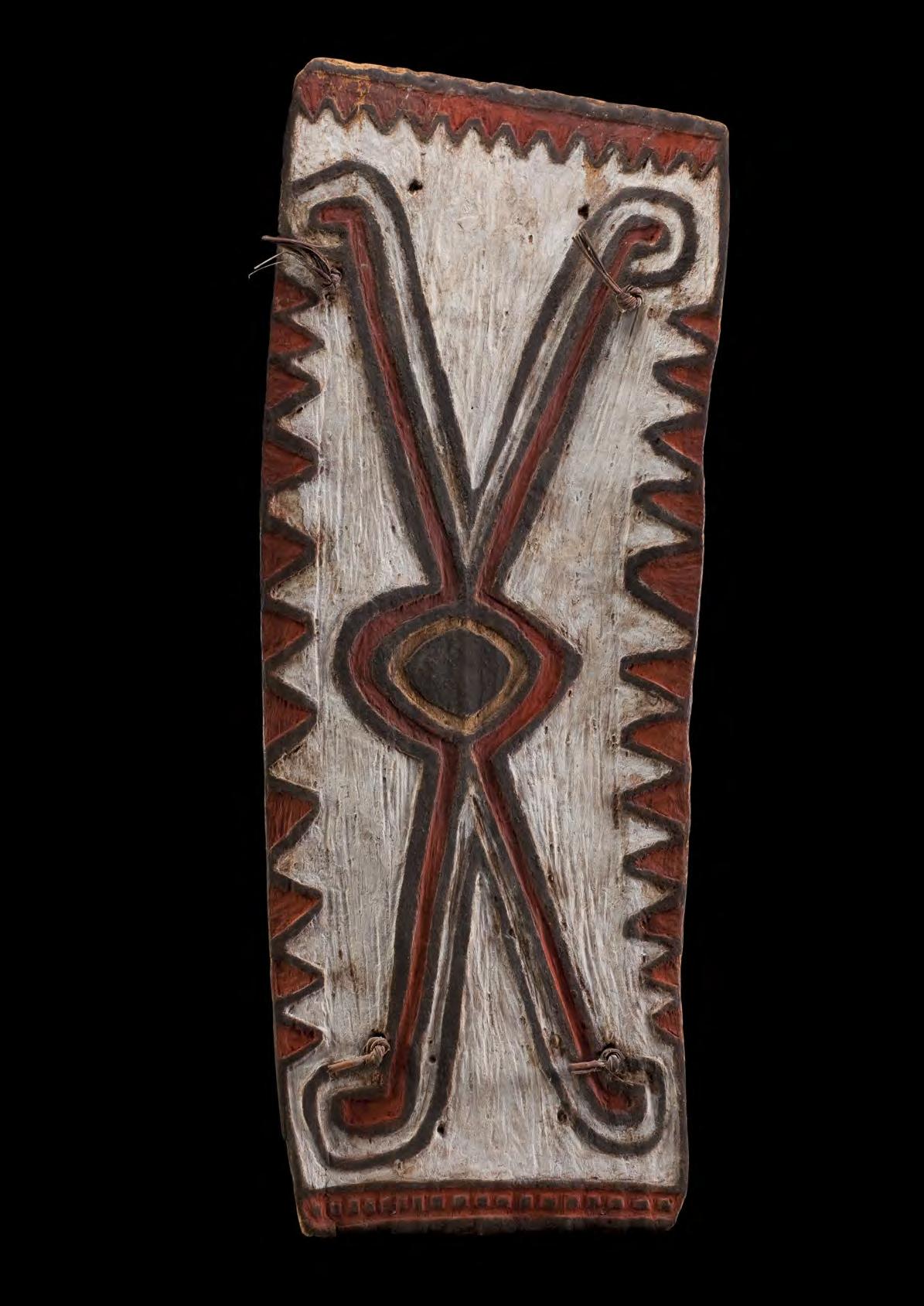
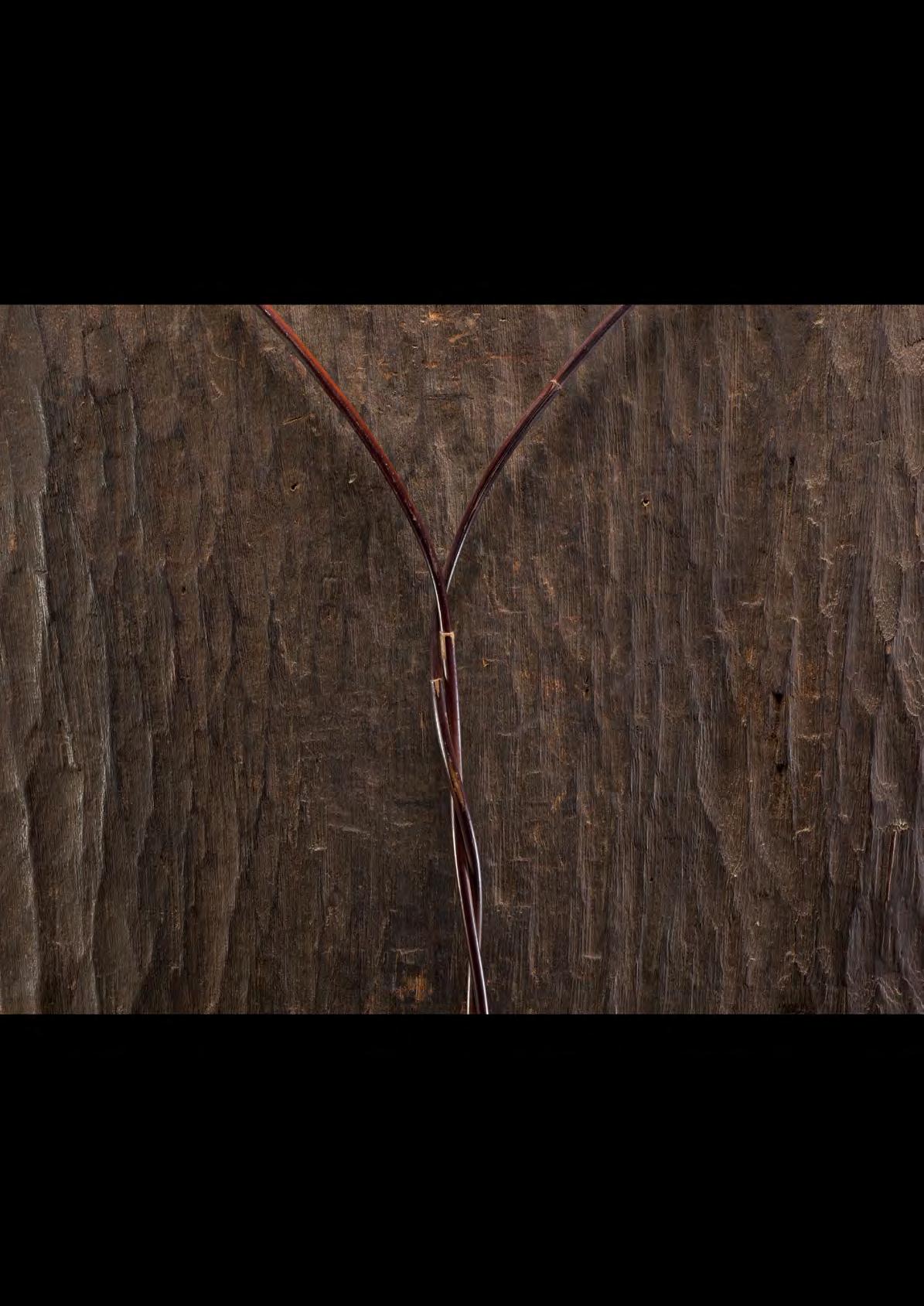


A war shield called Duranmin, held by Obal of Oksivip village, Kubrenmin parish, Ifitaman, Telefolmin, 1967. Photo by Barry Craig
27 Middle Sepik River War Trumpet
Iatmul culture, Middle Sepik River, East Sepik Province,
Papua New Guinea Sotheby’s London, 10 December 1974, lot 129 Christie’s New York, 4 November 1994, lot 19 Sydney and Lynn Lerman Collection, New York, acquired from the above auction By Descent to Mark Lerman, Richmond, Virginia Late 19th/early 20th century 523/8” (133 cm) in height
Trumpets such as this were taken into battle and would, if successful, be blown before reaching the home village to signal the number of enemies killed. This one is exceptional for its scale and the beauty of its carved design. I especially love the trail of repeating tongue motifs leading up from the spirit face at the base all the way to the main ancestral head at the top, encircling the mouth hole in its path.
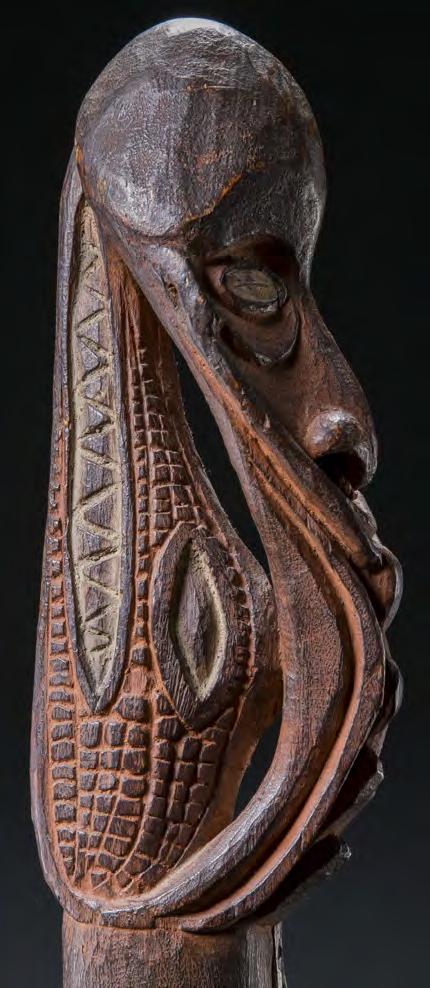
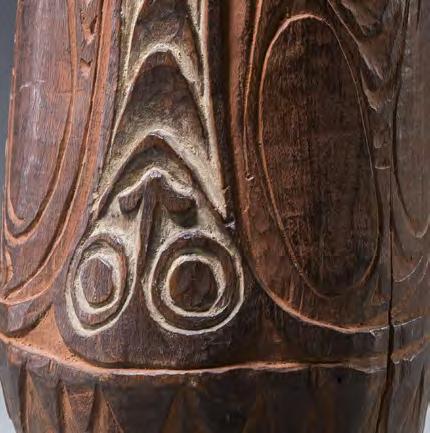
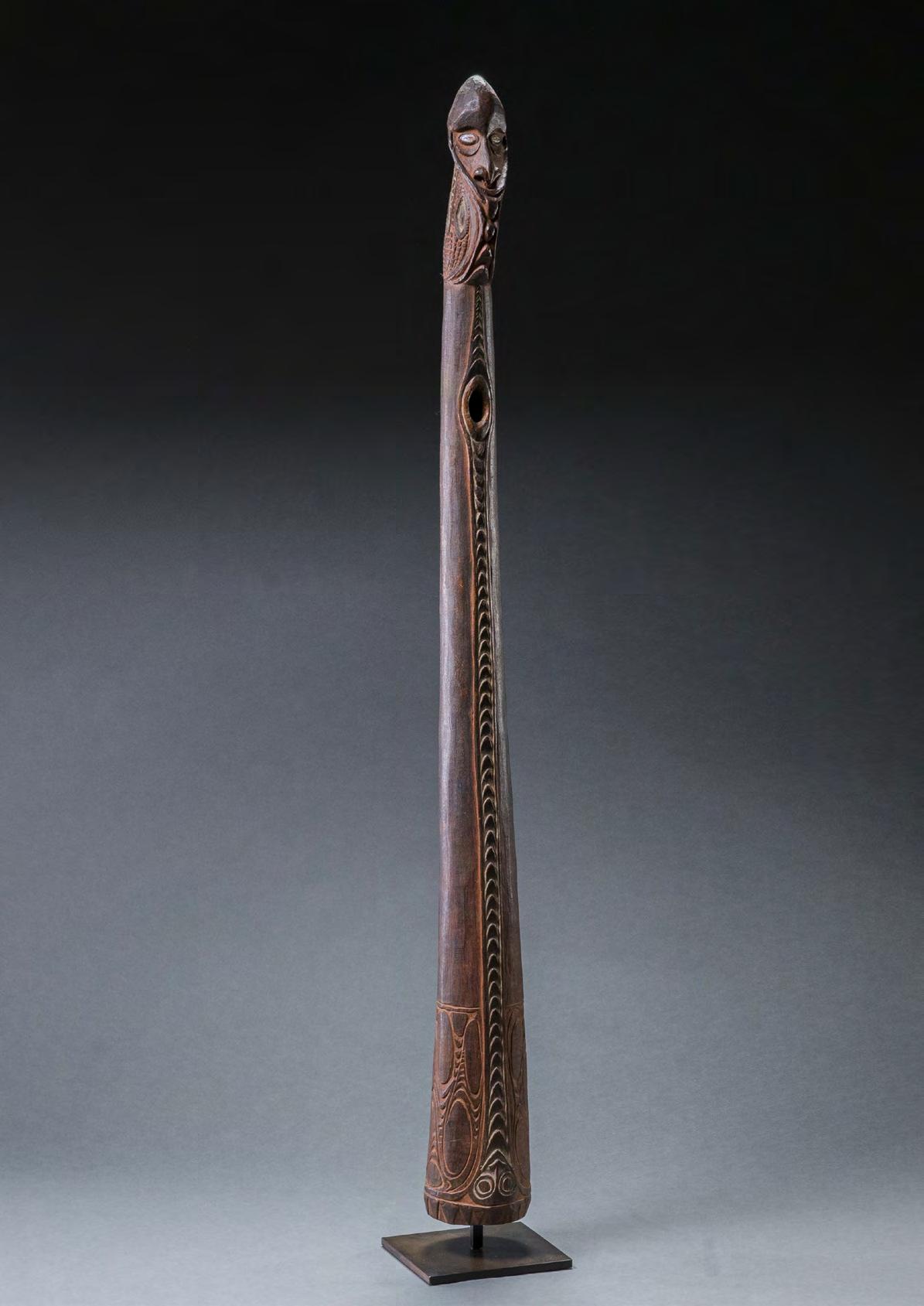
28 Western Desert Australia Stone Churinga
Kimberley region, Western Australia Collected at Fitzroy Crossing in the 1920s/30s American private collection since the 1970s Georgia Sales Collection, Belvedere, California 19th century 23 ½” (59.6 cm) in height
This superb large stone churinga has the classic Central Australia design of concentric circles and spirals. Daniel Sutherland Davidson wrote A Preliminary Consideration of Aboriginal Australian Decorative Art in 1937 for the American Philosophical Society. In it, he discusses the significance and meaning of the predominant concentric circle and spiral designs of stone churingas from the Arunta and Loritja people who were the main users of stone churingas. He makes note that individual interpretations of the designs vary, but what matters is the local’s ability to identify the totemic affiliation of each churinga. He goes on to state some of the meanings associated with the classic concentric circle design, “A group of concentric circles or a spiral, the most important motifs, are often interpreted as representing a totem center, the totemic animal or plant, a water-hole or some other natural feature of the terrain, a camp of human beings or of mythological totemic ancestors, the imprint in the earth left by a person’s buttocks, the intestines of an animal or bird, an egg, or other things or places of a similar nature” (p.95).
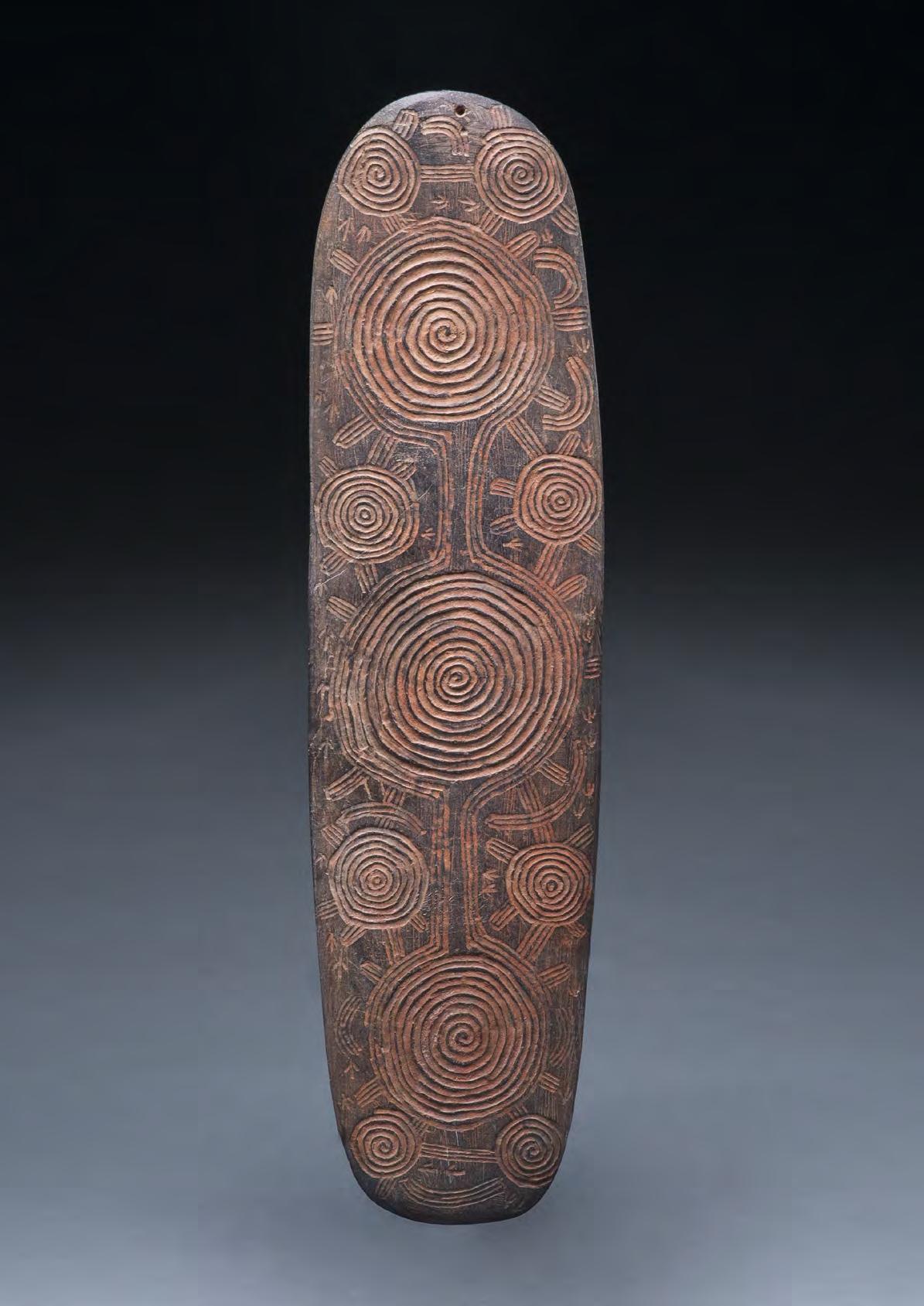
29 Fijian Gugu Club
Fiji Tad Dale, Santa Fe, New Mexico Will Hughes, Palos Verdes Estates, California Late 18th century 39 ¼” (99.7 cm) in height
Here is an old-style Fijian gugu club named after the butterfly fish. Carved from a dense hardwood, the shaft is oval and conspicuously unadorned and rough-hewn, contrasting with the delicate and precisely carved head. The Fijian art scholar Fergus Clunie suggests that gugu were used more for dance and ceremony than battle, but the weight and wear suggests something more homicidal. The age, wear, and lethality of the club can only be appreciated in hand.
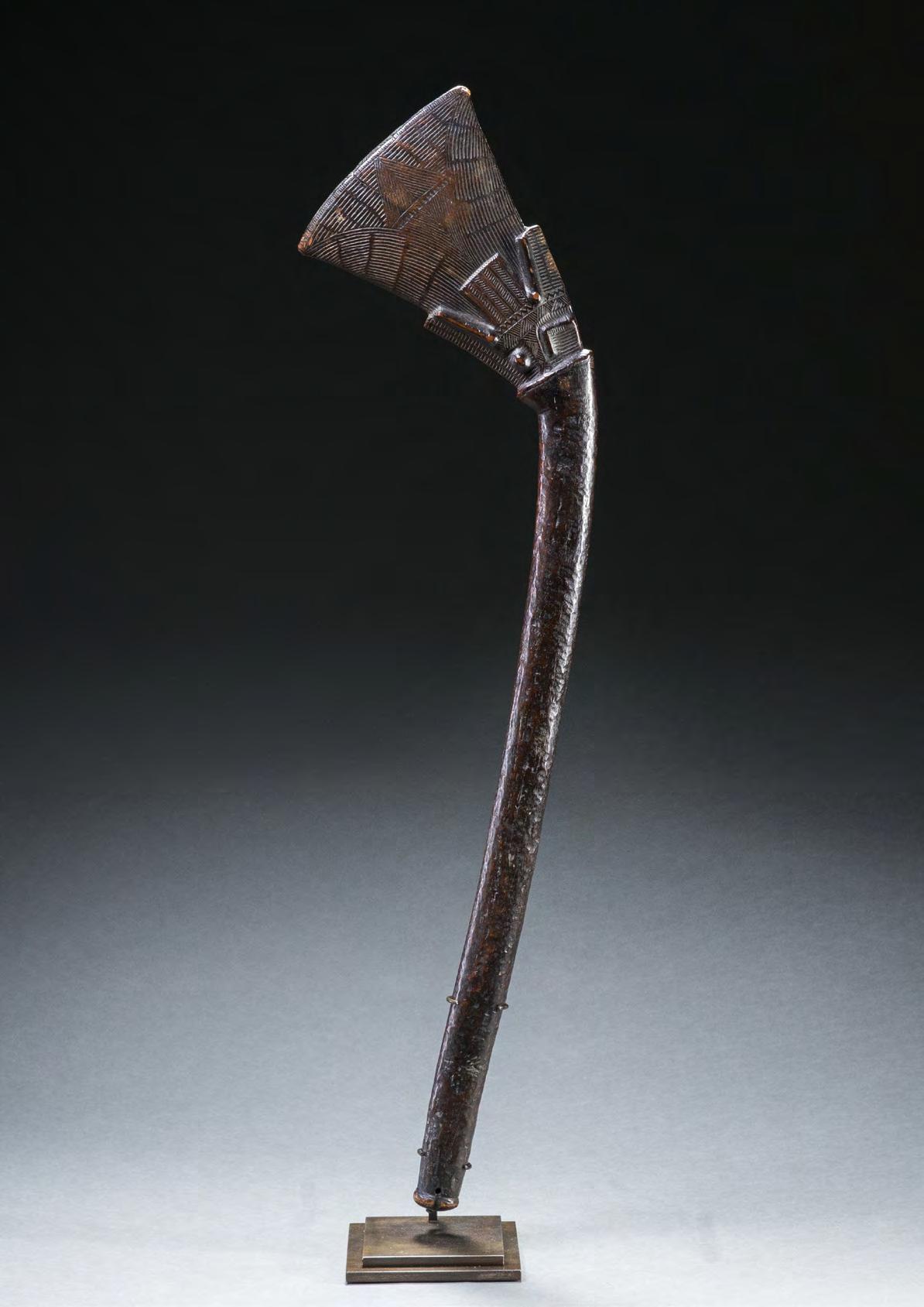


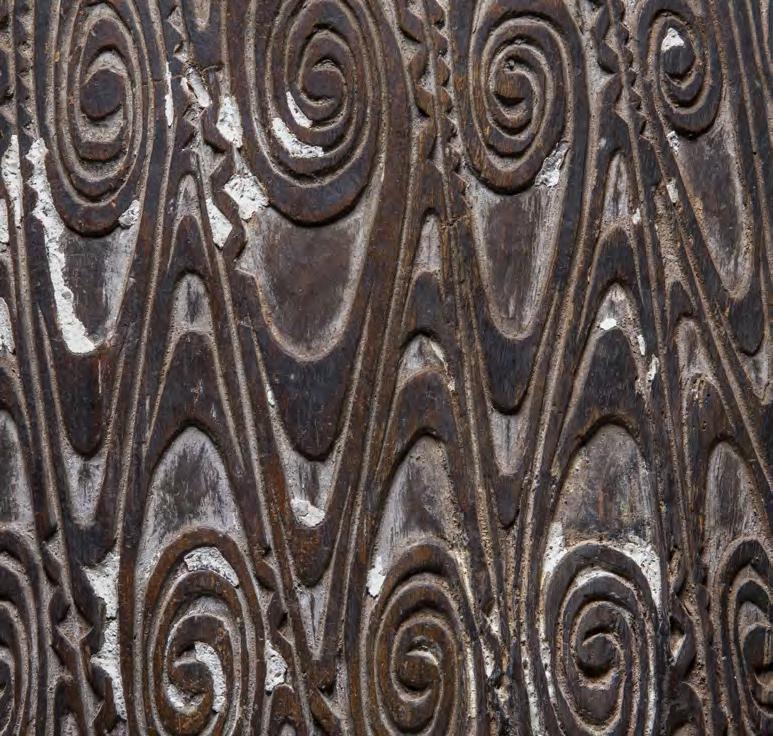
30 Lake Sentani Wooden Plate
Lake Sentani area, West Papua Collected by the American Army officer Woodruff Bryne in 1944 By descent through the family Early 20th century 263/8” (67 cm) in height
The art of Lake Sentani is justifiably renowned with the rare figure sculpture at the pinnacle of desirability in Oceanic art. Yet for me, the best Sentani art are the shallow oval wood dishes with carved undersides. Often the allover designs are superb examples of graphic art. The present example has a mesmerizing composition of spiral ovals that morph into undulating ripples that radiate out in waves as when a pebble is dropped into water. The clarity of this complex design is heightened by the white lime-filled shallow areas contrasted against the dark relief-carved patterns.
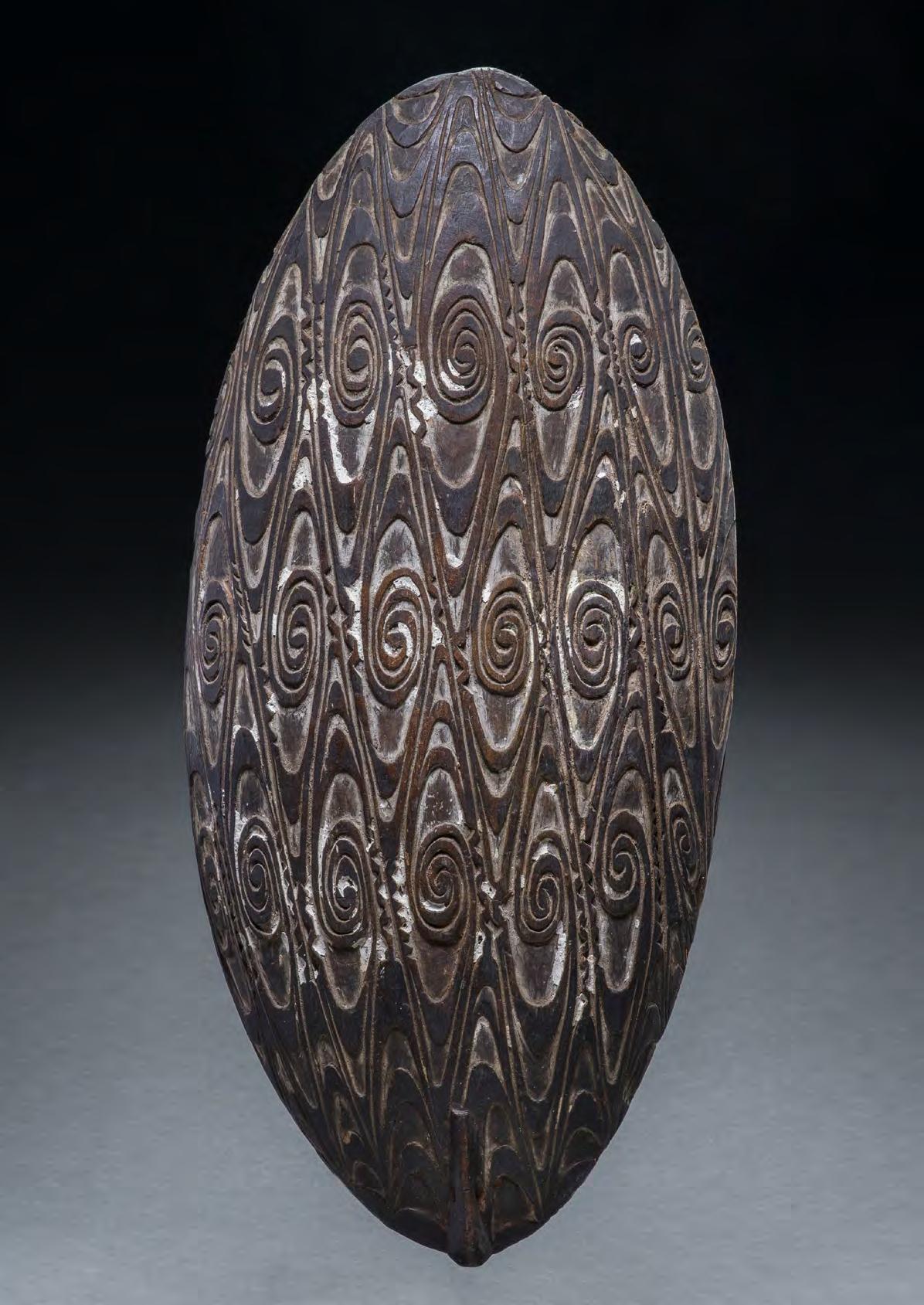
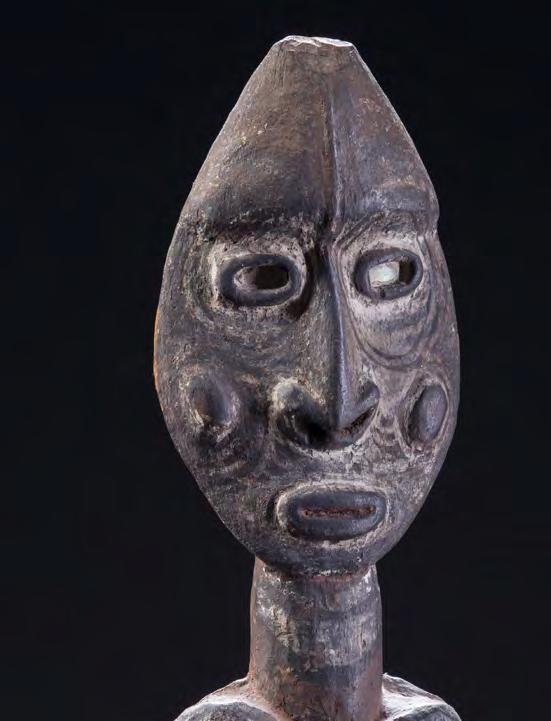
31 Middle Sepik River Suspension Hook
Iatmul culture, Middle Sepik River, East Sepik Province,
Papua New Guinea Southern England collection David and Bonnie Ross, Indianapolis Pasadena California private collection Illustrated in Michael Hamson Oceanic Art Paris 2011, no. 11 Michael Hamson Oceanic Art Paris 2018, no. 32 Pre-contact, stone-carved, late 19th century 24¾” (62.9 cm) in height
This ancient pre-contact suspension hook is exceptional for its powerful expression, delicacy of its painted design, and the ingenious use of fish motifs—the mudfish head as the basis of the bottom hook and the fish for shoulder blades. This represents the best in Sepik River art—the rough-hewn quality of a pre-contact piece combined with the finesse and creativity for which the area is known.
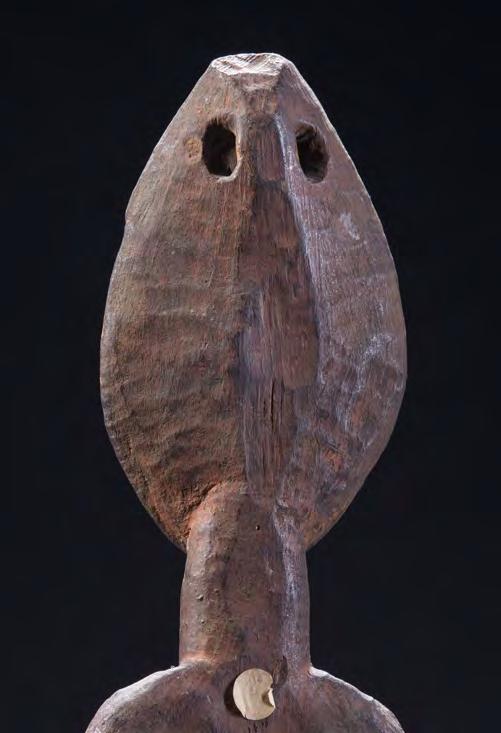
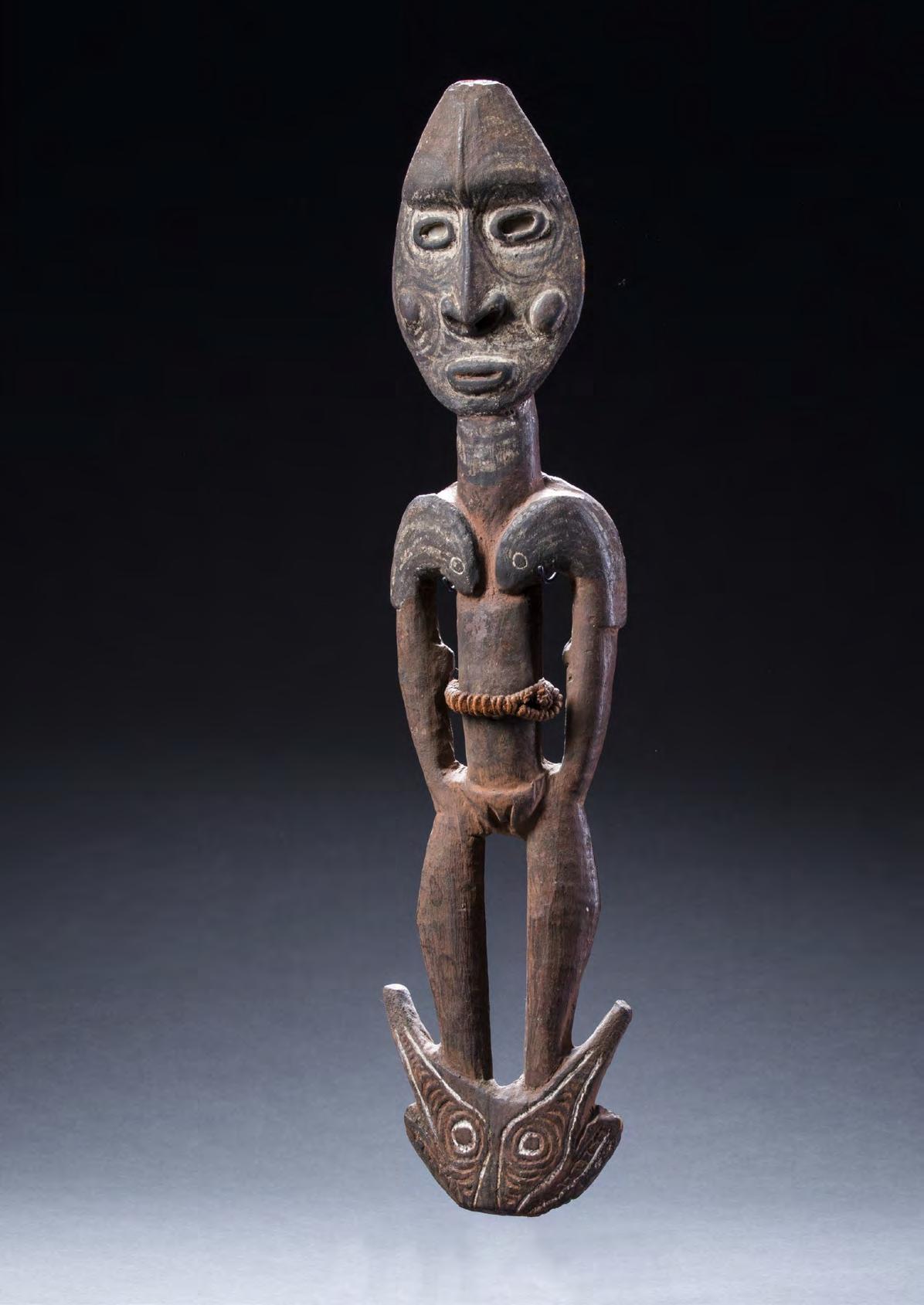
Tami Island or Huon Gulf region, Morobe Province, Papua New Guinea Collected by Nancy Thomas, late 1960s/early 1970s Sidney Rosen Collection, Phoenix, Arizona 19th century 29 ½” (75 cm) in length
There was a time in the mid 1990s that I spent a lot of time field collecting wooden bowls in the Huon Gulf region of Morobe Province, Papua New Guinea. I focused on the remote villages well inland and up the slopes of the volcanic Umboi Island. Here the people had their old wooden bowls lying in the rafters, with smaller ones nested inside the larger dishes. After nearly collapsing a number of local bush-material houses by hoisting my body up into the rafters, I got quite adept at recognizing good old bowls. The present one was in a Phoenix, Arizona mansion, and its quality could be spotted from across the room. It is ancient with a gorgeous deep-black and glossy patina and raised relief-carved stylized crocodiles. It is hard to convey the pleasure of holding a beautifully carved wooden object that generations of wear and use have given a polished jewel-like surface.
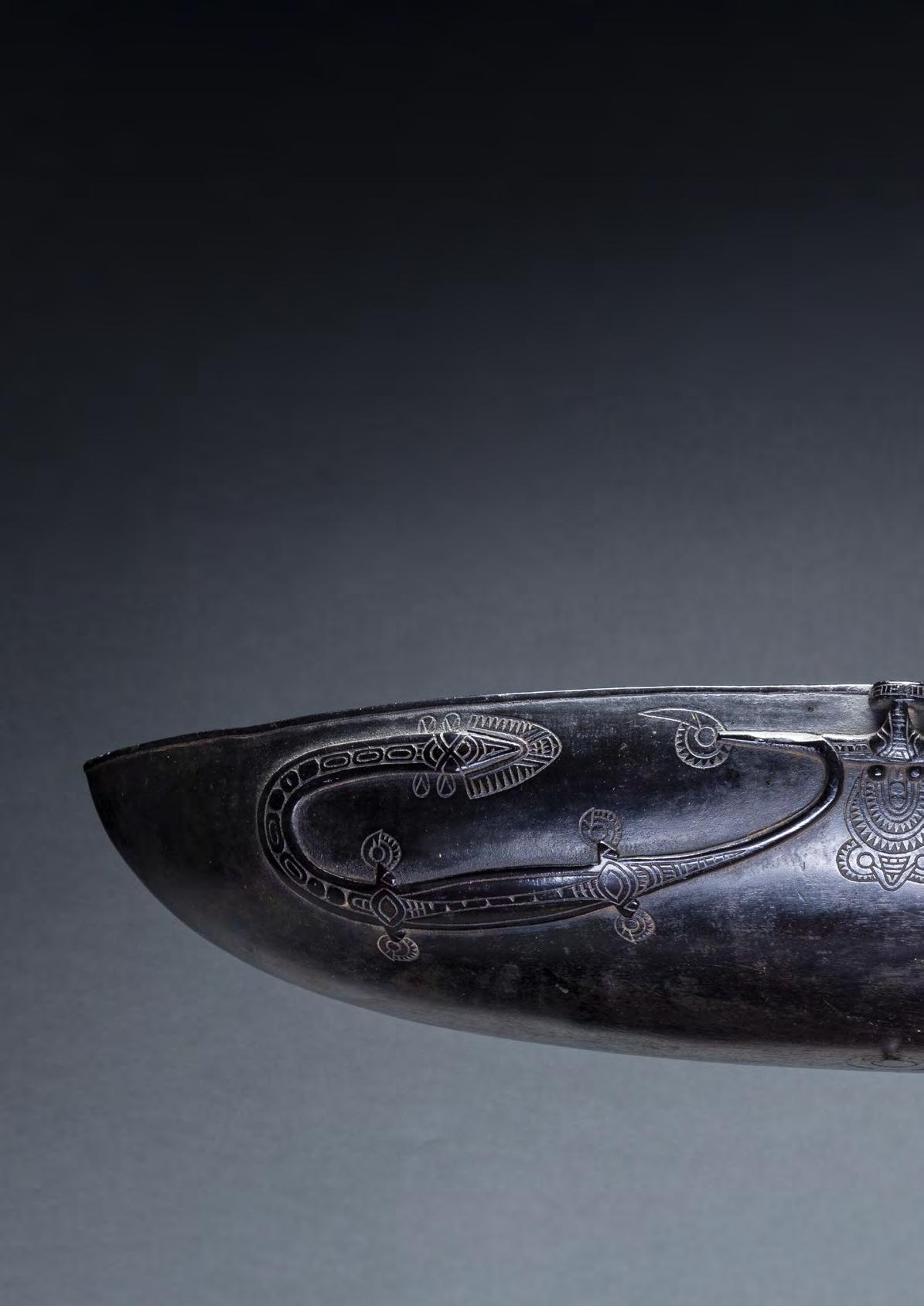
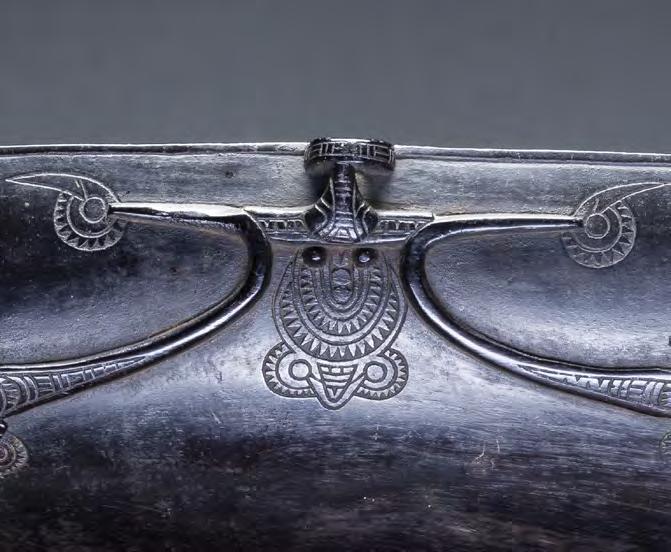
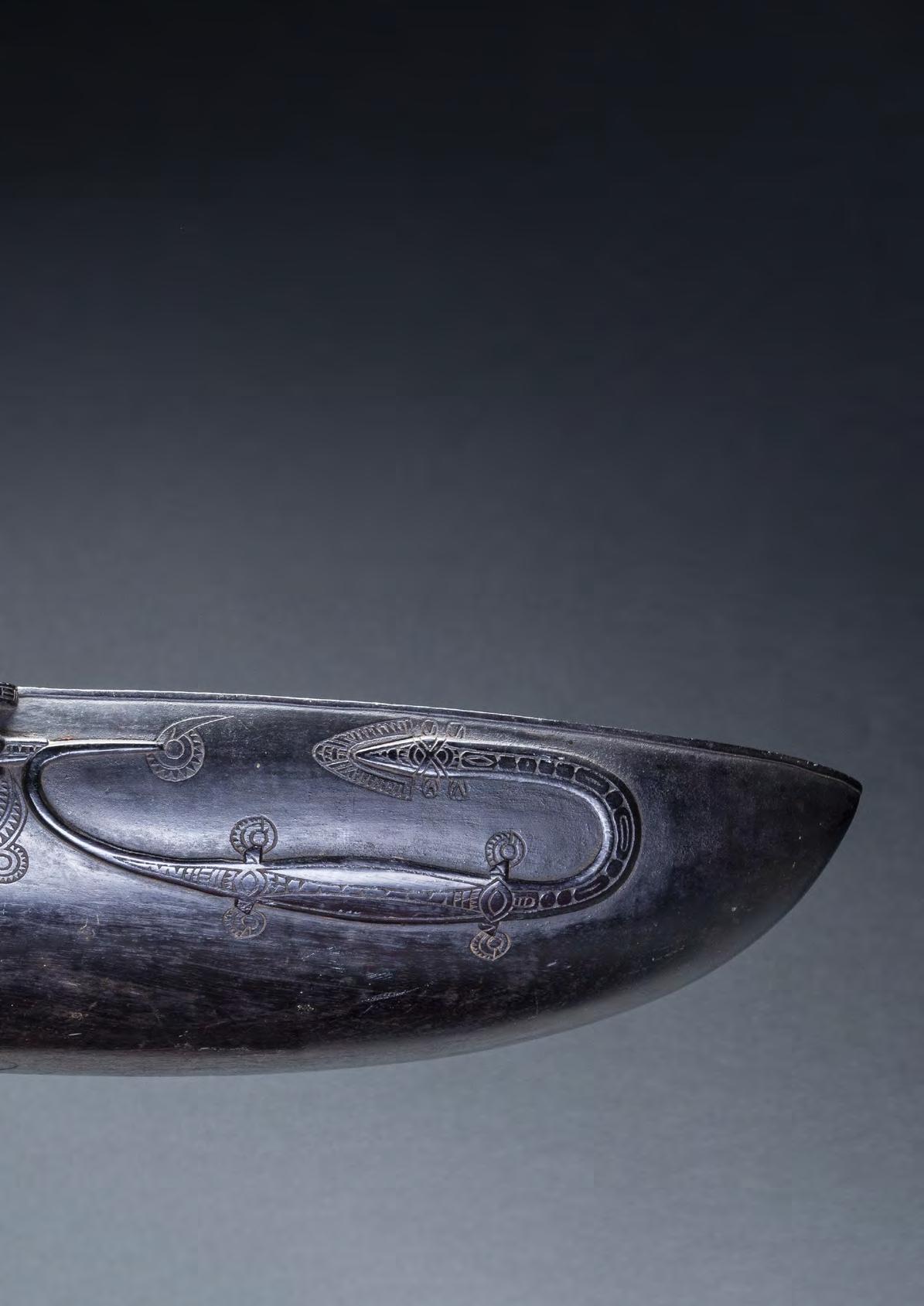
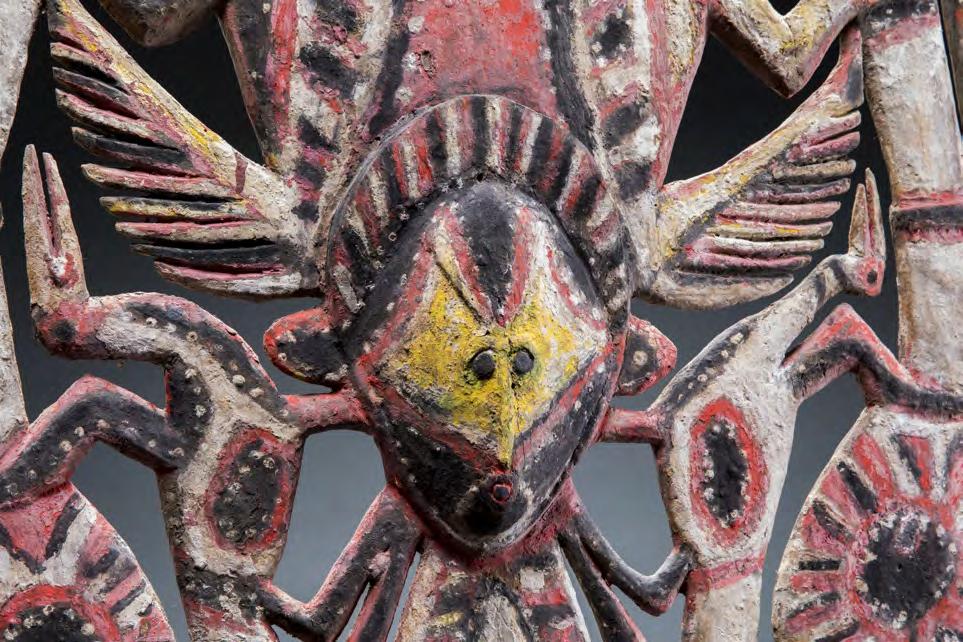
33 Abelam Wooden Headdress, Wakan
Kwambigum village, southeastern Abelam area toward Roma village, East Sepik Province, Papua New Guinea Field collected by Michael Kremerskothen, Dortmund, Germany Published Art of the Abelam, by Michael Hamson, 2015, no. 112, p. 208 Early 20th century or before 373/8” (95 cm) in height
I have known of this old Abelam wooden headdress for decades and feel fortunate to have been able to acquire it for this exhibition. As a former field collector who spent a lot of time in the Abelam area, I was always attracted to the age and delicacy of this piece. The openwork design is a complex composition of a central ancestral spirit surrounded by totemic birds. The headdress is remarkable for its obvious long ceremonial life. When an artifact is repeatedly used through the generations, it continually earns its cultural significance. This importance can be both seen and felt in the object itself, from the worn rounded edges and thick layers of magical paint. It is that combination in this headdress of a light, airy structure with the heavy ritual residue that I personally find so compelling.
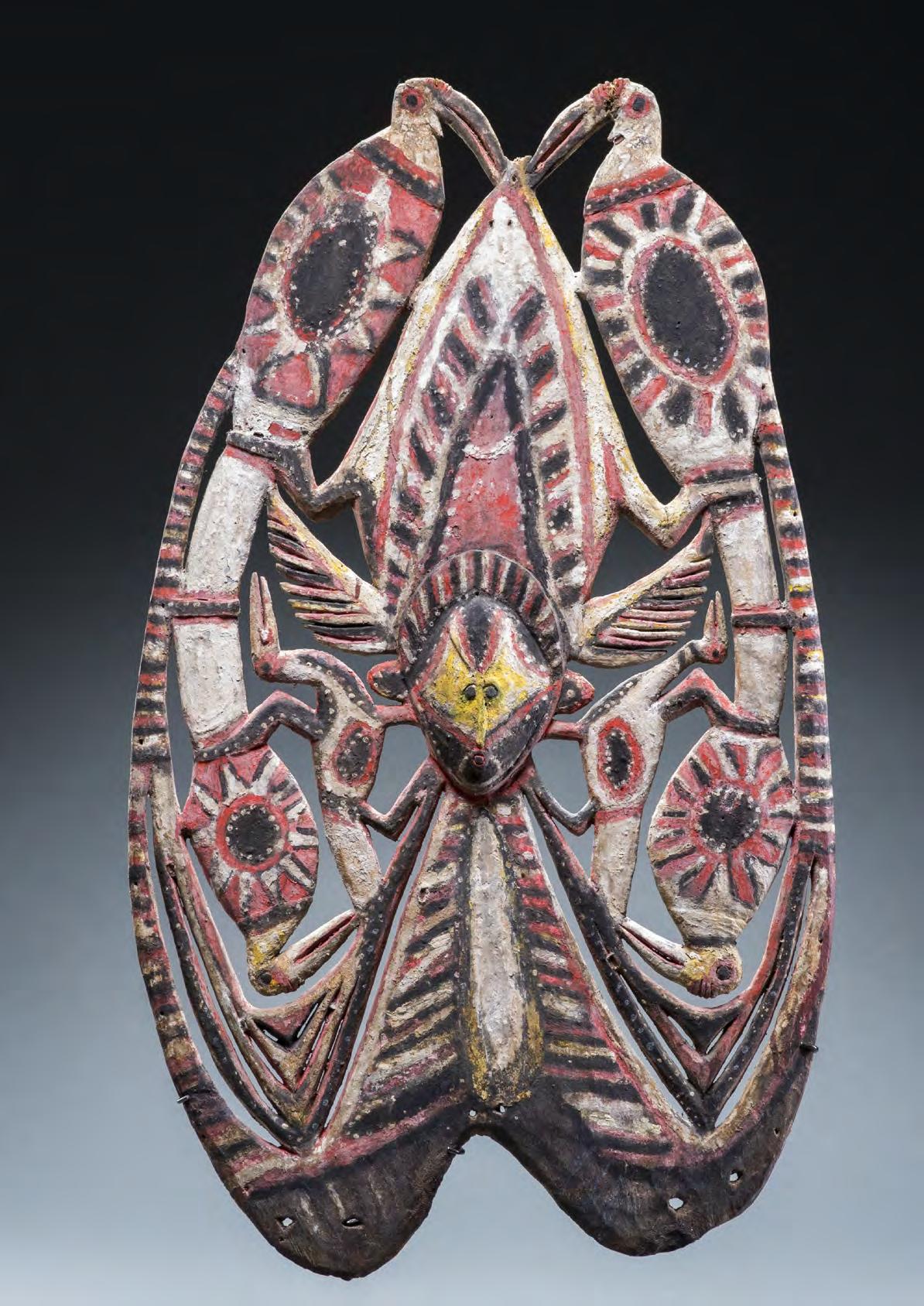
34 Massim Lime Spatula Figure
Massim culture, Milne Bay Province, Papua
New Guinea Private collection, London, 1970s New York collection Skinner Auction, Boston, 2011 19th century 6 ½” (16.5 cm) in height
Often the figurative sections of Massim lime spatulas are quite stylized and embellished with intricate designs carved onto the surface—making them visually interesting but somewhat decorative. It is rare to get a true figure, unadorned, with its power generated by its sculptural form. On this example, the limbs, while thin and delicate, have a strength from their being connected at the joints and being looped back to the solid torso. The face is wide-eyed and smiling, the head jutting forward and low to the body—the latter being a consistent indicator of an early style in New Guinea figurative art. The deep, glossy patina corroborates this antiquity.
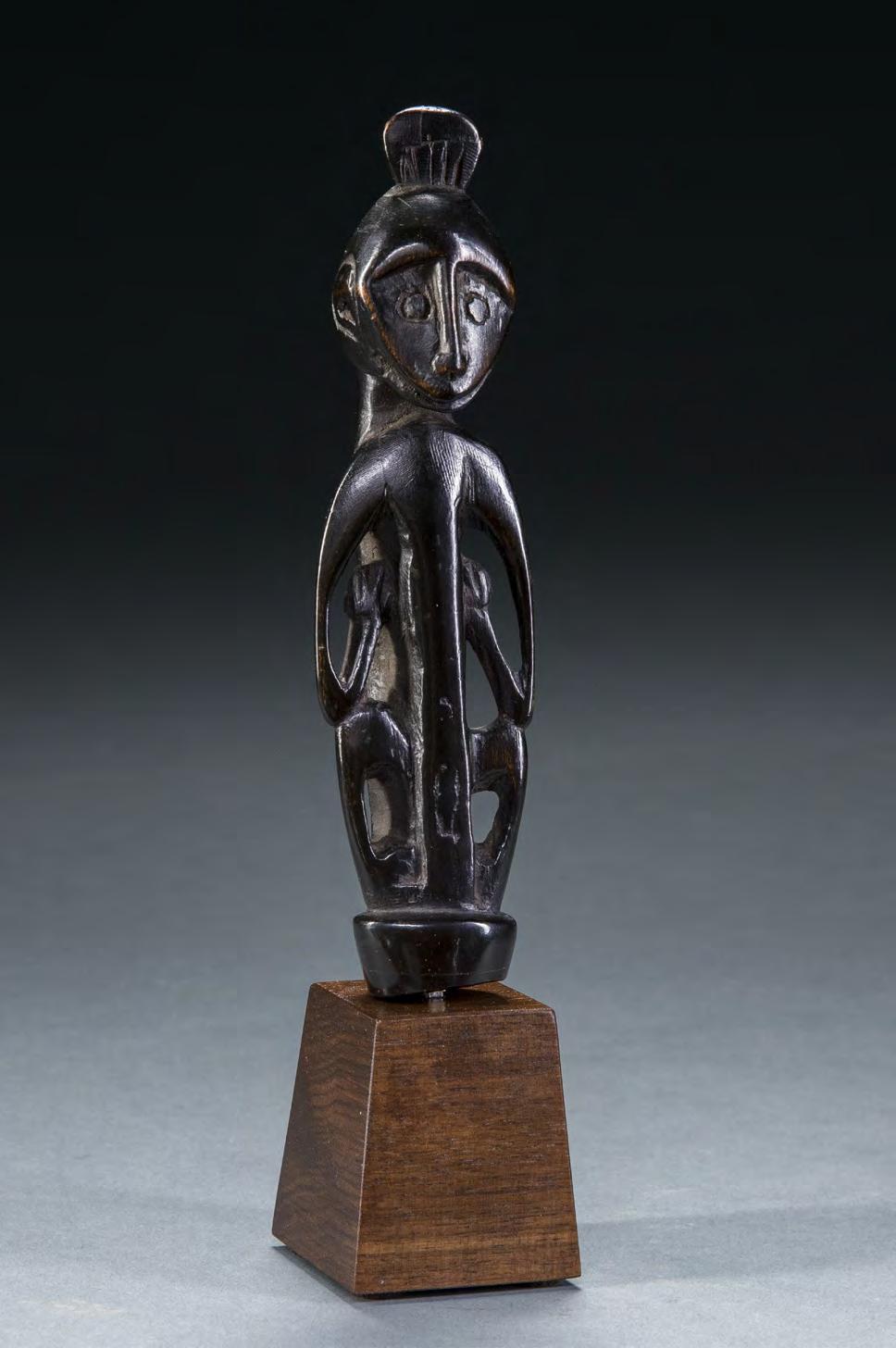
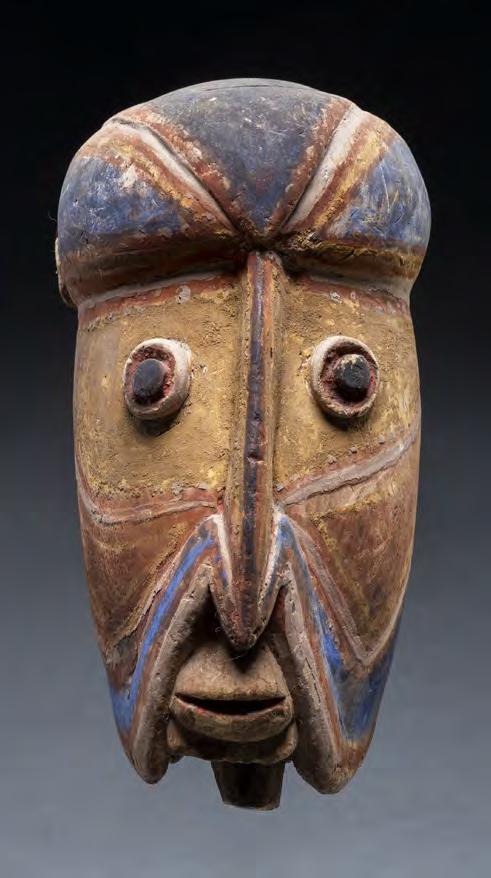
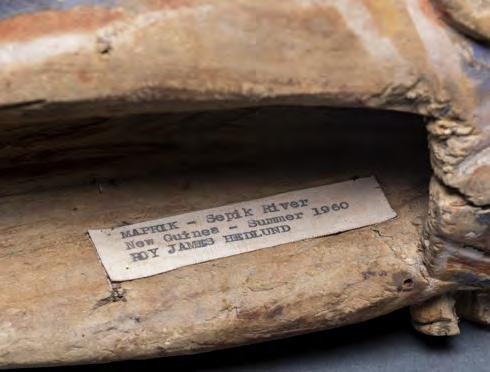
35 Southern Abelam Balsawood Yam Mask
Southern Abelam area known as the Wosera,
East Sepik Province, Papua New Guinea Field collected by Roy James Hedlund, summer 1960 Edward M. Brownlee Collection, Honolulu By descent through the family Early 20th century 10 ¼” (26 cm) in height
Abelam yam masks are predominantly made with strips of cane using the coiling technique—often incorrectly called woven yam masks. Then there are the wooden versions often found in the central and eastern Abelam areas. These often are somewhat flat with oval spirit faces painted with a fairly conventional Abelam style. But there are also the balsawood yam masks from the southern Abelam. It must be the very nature of the material, that soft, light, easily carved wood that allows such a freedom to the artist. With the hardwood versions the eyes are often just halfmoons below a crisp brow, the nose a thin raised ridge, the mouth a simple incised crescent. The beauty of the mask is left to the painted surface decoration. Here, on the balsawood example, the volumes inflate and become wonderfully full and rounded. Black has been replaced by blue to further confound expectations.
